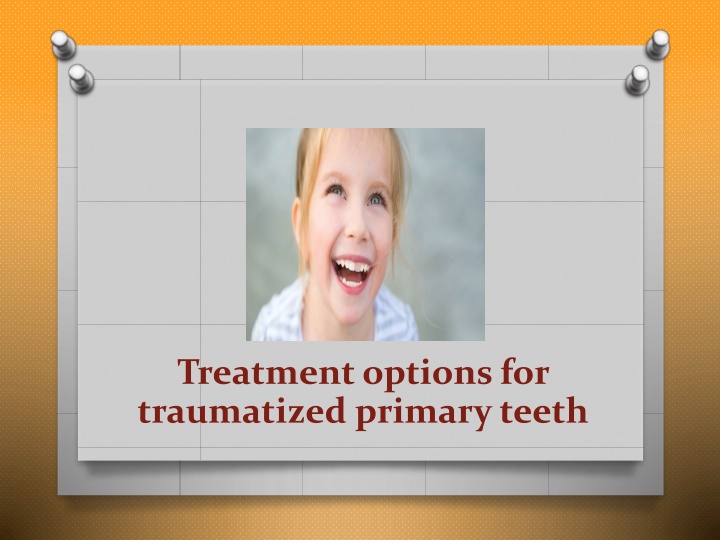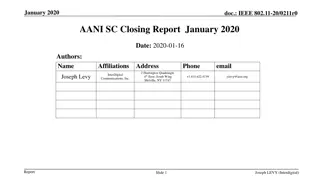
Treatment Options for Traumatized Primary Teeth – Causes, Types, and Management
This comprehensive guide covers the etiology, predisposing factors, types of injuries, history and examination, as well as advice and treatment options for trauma in primary teeth. Learn about the common causes, including accidents and sports injuries, and how to identify and manage different types of dental trauma in preschool-age children.
Download Presentation

Please find below an Image/Link to download the presentation.
The content on the website is provided AS IS for your information and personal use only. It may not be sold, licensed, or shared on other websites without obtaining consent from the author. If you encounter any issues during the download, it is possible that the publisher has removed the file from their server.
You are allowed to download the files provided on this website for personal or commercial use, subject to the condition that they are used lawfully. All files are the property of their respective owners.
The content on the website is provided AS IS for your information and personal use only. It may not be sold, licensed, or shared on other websites without obtaining consent from the author.
E N D
Presentation Transcript
Treatment options for traumatized primary teeth
Treatment options for traumatized primary teeth O Introduction Introduction O Etiology Etiology O Predisposing factors Predisposing factors O Types of injuries Types of injuries O History and examination History and examination O Advise and treatment Advise and treatment O Sequeles Sequeles
Introduction O Dental injury is a common injury Dental injury is a common injury O 1 1/ /3 3 preschool children preschool children sufford O Trauma results in pain, loss of function, esthetic & Trauma results in pain, loss of function, esthetic & psychological psychological O Peak incidence of dental trauma between Peak incidence of dental trauma between 1 1- -3 3 years years O Most affected teeth maxillary incisors Most affected teeth maxillary incisors sufford
Etiology 1. 1. Accidents & Accidents & sprots 2. 2. Oro tracheal intubation /premature infants Oro tracheal intubation /premature infants 3. 3. Non accidental injury or physical abuse Non accidental injury or physical abuse sprots
Predisposing factors 1. 1. Increase over jet Increase over jet 2. 2. Anterior open bite Anterior open bite 3. 3. Protrusion upper incisors Protrusion upper incisors 4. 4. Hyperactivity Hyperactivity 5. 5. Epilipsy Epilipsy
Types of injuries depends on: O Direction, intensity of force Direction, intensity of force O Luxation more common than fracture / primary Luxation more common than fracture / primary dentition dentition
Types of injuries 1. 1. crown crown fracture 2. 2. Root fracture Root fracture 3. 3. Crown root fracture Crown root fracture 4. 4. Concussion Concussion 5. 5. subluxation subluxation 6. 6. Luxation Luxation 7. 7. Avulsion Avulsion 8. 8. Alveolar process Alveolar process fracture
History and Examination O Time, cause Time, cause O Patient Medical history Patient Medical history O Head injuries Head injuries O Lost teeth, tooth fragments Lost teeth, tooth fragments A. A. Extra oral examination: Extra oral examination: Facial lacerations, haematomas haematomas, bleeding, facial bone injury or fracture , bleeding, facial bone injury or fracture B. B. Intra oral Intra oral examination: examination: soft tissue injury, teeth, soft tissue injury, teeth, alveolar bone alveolar bone C. C. Radiographic examination: reproducible long cone Radiographic examination: reproducible long cone technique technique periapicals periapicals, , occlusal occlusal view, extra oral lateral view lateral view Facial lacerations, view, extra oral
In a radiograph: In a radiograph:
O Concussion Concussion / tender to to touch touch Reassurance & Reassurance & maintenanse maintenanse Good oral hygiene Good oral hygiene / tender O Sub luxation / mobile, Sub luxation / mobile, bleeding bleeding Reassurance & Reassurance & maintenanse maintenanse Good oral hygiene Good oral hygiene 1. 1. 1. 1. 2. 2. 2. 2.
Sequelesof trauma to the primary teeth: 2 2- -Pulp obliteration: Pulp obliteration: O common, yellowish O Radiograph: obliteration pulp chamber, root canal. O No treatment/ No treatment/ normal normal exfolation exfolation. . 1 1- -Pulp necrosis Pulp necrosis: : O gray discoloration, loss of vitality O Radiograph: arrested root development, peri apical radiolucency. O Treatment : endo extraction extraction. endo. or . or
Sequelesof trauma to the primary teeth: 1 1- -Pulp necrosis Pulp necrosis 2 2- -Pulp Pulp obliteration obliteration
Sequelesof trauma to the primary teeth: 4 4- -External root External root resorption resorption: : O inflammatory, Signs of infection O Radiograph: tooth substance with R.L. alveolar bone. O Treatment: extraction 3 3- -Internal root Internal root resorption resorption: : O Uncommon, signs of infection O Radiograph: oval shape pulp chamber O Treatment: endo extraction extraction loss Adjacent endo. or . or extraction
Sequelesof trauma to the primary teeth: 4 4- -External root External root resorption resorption 3 3- -Internal root Internal root resorption resorption
Other Other (Rare) (Rare) 1. Dentigerous cyst formation 2. Root duplication 3. Sequestration permanent tooth germ 4. Partial or complete arrest of root formation










